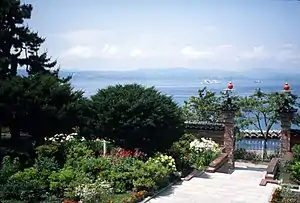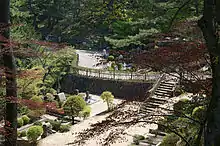Foreign cemeteries in Japan
The foreign cemeteries in Japan (外国人墓地, gaikokujin bochi, "foreigner cemetery") are chiefly located in Tokyo and at the former treaty ports of Kobe, Hakodate, Nagasaki, and Yokohama. They contain the mortal remains of long-term Japan residents or other foreigners who died in Japan, and are separate from any of the military cemeteries.

Hakodate
The Hakodate Foreign Cemetery, located in the Motomachi district, is just below Mt. Hakodate and over the coastal beach. The cemetery is divided into national and cultural sections; different local associations are responsible for the maintenance of each section. All graves face the ocean. They include the graves of two mariners from the fleet of Commodore Matthew Calbraith Perry.
Kobe

Kobe originally had two foreign cemeteries. One, Onohama, located in the foreign settlement, the other located in Kasugano.
In the early 1950s, the Kobe City Government began relocating all foreigners' graves to a new Foreigners' Cemetery, the Kobe Municipal Foreign Cemetery (神戸市立外国人墓地), in Futatabi Park in the hills high above the city. This was completed in 1962.
Mount Futatabi, in a pleasant woodland location, has the graves of many long-term residents, including Alexander Cameron Sim. James Joseph Enslie a long serving British Consular Officer in Kobe has a large grave in the cemetery.
George French, the Chief Justice of the British Supreme Court for China and Japan was buried in Onohama in 1881.
Nagasaki
Nagasaki has three main international cemeteries: 1) Inasa International Cemetery, which is the oldest foreign cemetery in Japan and consists of separate plots for Chinese, Dutch and Russian people; 2) Oura International Cemetery, which was established in the early 1860s near the site of the Nagasaki foreign settlement and served the foreign community until being closed in 1888; and 3) Sakamoto International Cemetery, which has some 440 graves including that of Scottish merchant Thomas Blake Glover.[1]
Naha
There is a foreign cemetery in Naha, Okinawa. The earliest graves are of Chinese sailors. Several contemporaries of Matthew C. Perry are buried there.
Shimoda
Four members of American Commodore Matthew Perry's flotilla are buried in the cemetery of the small Buddhist temple of Gyokusen-ji that served as the first America consulate in Japan. Another American and three Russians were also buried there in the 1850s.
Tokyo
The Tokyo foreign cemetery is a section of the Aoyama Cemetery in Aoyama, Tokyo. By 2005 it was under threat from the city's bureaucracy, which threatened to remove graves for which fees had not been paid by families of the deceased. The Foreign Section Trust[2] was formed to campaign to preserve the foreign part of the cemetery. Eventually the situation was rectified and the foreign section is now a protected monument, commemorating the men and women who helped build Japan in the late 19th century.[3]
These are the graves of expatriates from the Meiji era, men and women who promoted Western ideas and practices in Japan—doctors, educators, missionaries, and artists. Many of them were o-yatoi gaikokujin.
Famous non-Japanese buried there include the British minister plenipotentiary Hugh Fraser who died in the post in 1894, Captain Francis Brinkley, Guido Verbeck, Henry Spencer Palmer, Edoardo Chiossone, Joseph Heco, Edwin Dun, Mary True, and several others.
Yokohama
Yokohama Foreign General Cemetery

The Yokohama Foreign General Cemetery, located in Yamate Naka-ku, Yokohama, includes among many others the grave of Charles Lennox Richardson, murdered in the Namamugi Incident in September 1862, John Wilson, and that of Charles Wirgman, Ludovicus Stornebrink, and John Carey Hall. The French military advisors of the Boshin War, François Bouffier, Jean Marlin, and Auguste Pradier are also buried there.
First established in 1859 soon after the opening of the Port of Yokohama. The current cemetery consists of 22 sections in an area of 18,500 square meters. In 1864, a memorandum for the foreign settlement at Yokohama was signed by the Tokugawa shogunate with the legations of the main trading nations permitting the extension of the cemetery area to the top of the Bluff opposite the Anglican Christ Church.[4]
On the weekends of the spring, summer and fall (from noon to 4:00 p.m.), the cemetery is opened up to the public for a small donation to help with the upkeep of the premises. Visitors will get a small pamphlet showing graves of interest, and they can also view the museum at the site. These events are organized by the Yokohama Foreign General Cemetery Foundation which is responsible for the upkeep and general maintenance of the cemetery, considered a very important historic spot in Yokohama.
The Yokohama Cemetery has undergone recent revisions inspired by a generous bequest by conductor Seiji Ozawa, whose parents-in-law are buried there.
Negishi Foreign Cemetery
There is another section near Yamate Station on the Keihin-Tōhoku Line, called "Negishi Foreign Cemetery". It was established in 1880, but first used in 1902. Many of the 1923 Great Kantō earthquake victims were buried there.
Yokohama War Cemetery
Hodogaya-ku, Yokohama is also home to the Yokohama War Cemetery, the only military cemetery in Japan administered by the Commonwealth War Graves Commission. The cemetery contains the graves of 1,555 service personnel from the Second World War who died in conflict, prisoners of war and service personnel from the post-war occupation period. The war graves themselves are split up according to nationality with sections for British, Australia/New Zealand as well as Indian graves.
Nanjing Cemetery
Yokohama also has a Chinese cemetery near Negishi Park, called "Nanjing Cemetery". It was used to store the remains of Chinese from China town before being sent back to the mainland.
See also
- o-yatoi gaikokujin
- Heads of the United Kingdom Mission in Japan
- Anglo-Japanese relations
- Franco-Japanese relations
- Find A Grave cemeteries in Japan
- Japanese cemeteries and cenotaphs in overseas
References
- Tales of the Nagasaki International Cemeteries
- Minor Sights: Aoyama Cemetery
- "Brief History of the Yokohama Foreign General Cemetery". The Yokohama Foreign General Cemetery. YFGC Official Site. Retrieved 6 June 2014.
External links
- The Foreign Section Trust - formed in 2005 to preserve the foreign section of Aoyama cemetery in Tokyo.
- Tales of the Nagasaki International Cemeteries
- Tokyo scraps eviction policy for tombs of foreigners in Japan - Asahi Shimbun, October 20, 2005
- The Yokohama Foreign General Cemetery Foundation - Foundation formed in 1900 to maintain the Yokohama Foreign General Cemetery
- Kobe City Government webpage (in Japanese) for the Kobe Foreign Cemetery